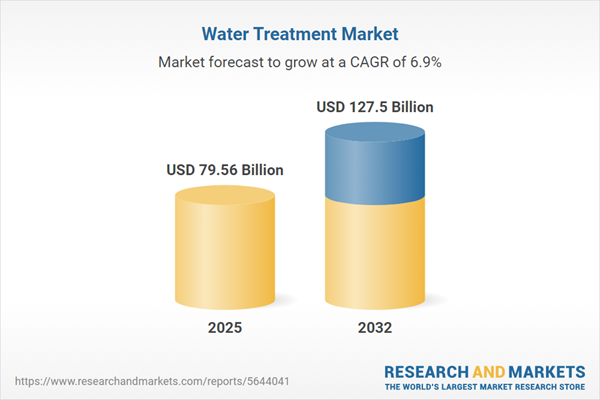Speak directly to the analyst to clarify any post sales queries you may have.
The water treatment market is undergoing accelerated transformation as environmental pressures and regulatory mandates converge, prompting organizations worldwide to pursue advanced solutions for resource stewardship, compliance, and long-term resilience.
Market Snapshot: Water Treatment Market Growth and Outlook
The Water Treatment Market grew from USD 74.76 billion in 2024 to USD 79.56 billion in 2025. It is expected to continue growing at a CAGR of 6.90%, reaching USD 127.50 billion by 2032.
Scope & Segmentation of the Water Treatment Market
This comprehensive analysis offers critical insight into the segments and technologies shaping global water treatment strategy, investment, and deployment.
- Product: Chemicals (Biocides & Disinfectants, Coagulants & Flocculants, Corrosion Inhibitors, Scale Inhibitors), Equipment (Disinfection Systems—Chlorination, Ozone, UV Systems, Distillation Systems, Filtration Systems, Ion Exchange Systems, Membrane Systems, Sludge Management Equipment), Services (Consulting, Installation, Maintenance)
- Technology: Adsorption, Electrodialysis, Ion Exchange, Microfiltration, Nanofiltration, Reverse Osmosis, Ultrafiltration
- Water Source Type: Brackish Water, Groundwater, Seawater, Surface Water, Wastewater
- Process Type: Biological, Chemical, Physical
- Application: Commercial, Domestic, Industrial (Chemical, Food & Beverage, Mining, Oil & Gas, Pharmaceuticals, Power Generation), Municipal
- Region: Americas (United States, Canada, Mexico, Brazil, Argentina, Chile, Colombia, Peru), Europe (United Kingdom, Germany, France, Russia, Italy, Spain, Netherlands, Sweden, Poland, Switzerland), Middle East (United Arab Emirates, Saudi Arabia, Qatar, Turkey, Israel), Africa (South Africa, Nigeria, Egypt, Kenya), Asia-Pacific (China, India, Japan, Australia, South Korea, Indonesia, Thailand, Malaysia, Singapore, Taiwan)
- Industry Coverage: Companies including Alfa Laval AB, Arvia Water Technologies Ltd, BASF SE, ChemTreat (Danaher), DuPont, Ecolab, and Veolia Environnement SA
Key Takeaways for Strategic Decision-Making
- Stringent environmental and regulatory pressures are compelling organizations to modernize treatment processes with digital monitoring, predictive analytics, and automation to drive compliance and operational efficiency.
- Growing adoption of membrane technologies, modular treatment units, and advanced oxidation processes is enabling tailored solutions to meet nuanced industrial, municipal, and regional water quality needs.
- Sustainability mandates and public awareness are accelerating a shift toward circular economy principles through resource recovery, water reuse, and reduction of environmental footprints across projects.
- Strategic partnerships between technology providers, end users, and service entities are facilitating holistic, integrated solutions and furthering innovation across both core and emerging markets.
- Regional dynamics—including water scarcity, infrastructure modernization, and cross-border regulatory differences—require adaptive approaches and localized investment in technology and service models.
- Industry leaders leverage portfolio depth and collaborative ecosystems to deliver modular systems, advanced chemical solutions, and high-value services, setting benchmarks for operational excellence.
Tariff Impact: US Supply Chain and Sourcing Shifts
Recent changes in US import tariffs on water treatment equipment and chemicals have intensified scrutiny of procurement channels and supply chain strategies. Manufacturers and service providers are accelerating diversification toward domestic production, local partnerships, and alternative technologies. This realignment reduces supply risks, shortens lead times, and supports cost management as firms navigate evolving trade and regulatory conditions.
Market Research Methodology & Data Sources
This report integrates insights from in-depth executive and technical interviews, regulatory review, and comprehensive analysis of industry publications. Each finding is validated through triangulation with publicly available case studies and external expert panels to ensure reliability and practical relevance for stakeholders.
Why This Report Matters: Enabling Actionable Outcomes
- Empowers decision-makers to align resource allocation and technology investment with the most promising water treatment market opportunities.
- Supports informed strategy by detailing regulatory shifts, sustainability imperatives, and emerging technology integration across critical applications and geographies.
- Provides a validated knowledge base to de-risk procurement, strengthen supply chain resilience, and accelerate transition to circular resource models.
Conclusion
The water treatment market landscape is evolving rapidly, shaped by sustainability, regulation, technological advancement, and shifting regional priorities. Stakeholders equipped with actionable intelligence from this research will be well positioned to drive sustainable growth and secure resilient water solutions across industries.
Additional Product Information:
- Purchase of this report includes 1 year online access with quarterly updates.
- This report can be updated on request. Please contact our Customer Experience team using the Ask a Question widget on our website.
Table of Contents
3. Executive Summary
4. Market Overview
7. Cumulative Impact of Artificial Intelligence 2025
Companies Mentioned
The companies profiled in this Water Treatment market report include:- Alfa Laval AB
- Arvia Water Technologies Ltd
- BASF SE
- ChemTreat, Inc. by Danaher Corporation
- Clean TeQ Water Limited
- DuPont de Nemours, Inc.
- Ecolab Inc.
- Fugro NV
- GE Vernova Company
- Gradiant Corporation
- Kingspan Group
- Kurita Water Industries Ltd
- LG Sonic B.V.
- Membrion, Inc.
- Nanostone Water, Inc.
- Ostara by Wheatsheaf Group
- Siemens AG
- SUEZ SA
- Dow Chemical Company
- Toshiba Corporation
- Veolia Environnement SA
- Xylem Inc.
- Pentair plc
- Kemira Oyj
- Doosan Enerbility Co., Ltd.
Table Information
| Report Attribute | Details |
|---|---|
| No. of Pages | 192 |
| Published | November 2025 |
| Forecast Period | 2025 - 2032 |
| Estimated Market Value ( USD | $ 79.56 Billion |
| Forecasted Market Value ( USD | $ 127.5 Billion |
| Compound Annual Growth Rate | 6.9% |
| Regions Covered | Global |
| No. of Companies Mentioned | 26 |









